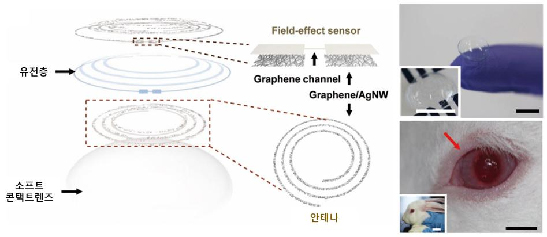
3. Science Fiction Type Contact Lens for |

![]() A research team in UNIST, South Korea has proposed a state of the art science fiction material - an in situ human health monitoring simply by wearing a contact lens with built-in wireless smart sensors.
A research team in UNIST, South Korea has proposed a state of the art science fiction material - an in situ human health monitoring simply by wearing a contact lens with built-in wireless smart sensors.
![]() This study has been jointly conducted by Professor Jang-Ung Park of Materials Science and Engineering, Professor Chang Young Lee of Life Science, and Professor Franklin Bien of Electrical and Computer Engineering at UNIST in collaboration with Professor Hong Kyun Kim of Ophthalmology and Professor Kwi-Hyun Bae of Internal Medicine at Kyungpook National University (KNU).
This study has been jointly conducted by Professor Jang-Ung Park of Materials Science and Engineering, Professor Chang Young Lee of Life Science, and Professor Franklin Bien of Electrical and Computer Engineering at UNIST in collaboration with Professor Hong Kyun Kim of Ophthalmology and Professor Kwi-Hyun Bae of Internal Medicine at Kyungpook National University (KNU).
![]() In the study, the research team designed a smart contact lens sensor that could help monitor biomarkers for intraocular pressure (IOP), diabetes mellitus, and other health conditions. The research team expects that this research breakthrough could lead to the development of bio-sensors capable of detecting and treating various human diseases, and used as a component of next-generation smart contact lens-related electronic devices.
In the study, the research team designed a smart contact lens sensor that could help monitor biomarkers for intraocular pressure (IOP), diabetes mellitus, and other health conditions. The research team expects that this research breakthrough could lead to the development of bio-sensors capable of detecting and treating various human diseases, and used as a component of next-generation smart contact lens-related electronic devices.
![]() This new smart contact lens sensors use electrodes made of highly stretchable and transparent graphene sheets and metal nano-wires. Through the embedded wireless antenna in the contact lens sensor, patients can also transmit their health information, which allows real-time monitoring of their health conditions, as well. In addition, because the system uses wireless antenna to read sensor information, no separate power source, like battery is required for the smart contact lens sensors.
This new smart contact lens sensors use electrodes made of highly stretchable and transparent graphene sheets and metal nano-wires. Through the embedded wireless antenna in the contact lens sensor, patients can also transmit their health information, which allows real-time monitoring of their health conditions, as well. In addition, because the system uses wireless antenna to read sensor information, no separate power source, like battery is required for the smart contact lens sensors.
![]() According to the research team, their newly-developed smart lenses with built-in pressure-sensing and glucose-monitoring sensors could still detect blood glucose and IOP despite the deformation of the contact lenses. The sensor characteristics were also maintained even when exposed to various substances in human tears.
According to the research team, their newly-developed smart lenses with built-in pressure-sensing and glucose-monitoring sensors could still detect blood glucose and IOP despite the deformation of the contact lenses. The sensor characteristics were also maintained even when exposed to various substances in human tears.
![]() "It was observed that the live rabbit did not show any abnormal behavior when wearing the contact lens sensor," says Joohee Kim (Combined M.S./Ph.D. student of Materials Science and Engineering), the first author of the study.
"It was observed that the live rabbit did not show any abnormal behavior when wearing the contact lens sensor," says Joohee Kim (Combined M.S./Ph.D. student of Materials Science and Engineering), the first author of the study.
![]() "This study can be used to diagnose diseases (diabetes and glaucoma) by implementing two types of transparent electronic sensors in the production of smart contact lens sensors," said Professor Park. "We are now a step closer to the implementation of a fictional idea for a smart contact lens in the films, like "Minority Report" and "Mission: Impossible."
"This study can be used to diagnose diseases (diabetes and glaucoma) by implementing two types of transparent electronic sensors in the production of smart contact lens sensors," said Professor Park. "We are now a step closer to the implementation of a fictional idea for a smart contact lens in the films, like "Minority Report" and "Mission: Impossible."
For enquiries info@jothydev.net.
Please visit: jothydev.net | research.jothydev.com | diabscreenkerala.net | jothydev.com/newsletter
